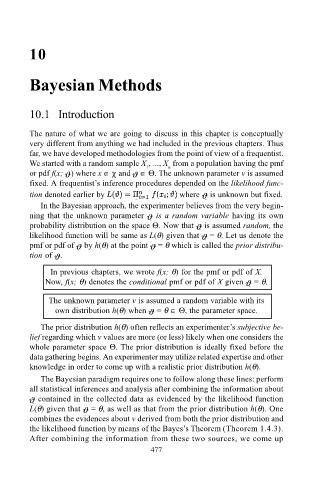Page 500 - Probability and Statistical Inference
P. 500
10
Bayesian Methods
10.1 Introduction
The nature of what we are going to discuss in this chapter is conceptually
very different from anything we had included in the previous chapters. Thus
far, we have developed methodologies from the point of view of a frequentist.
We started with a random sample X , ..., X from a population having the pmf
1
n
or pdf f(x; ) where x ∈ χ and ∈ Θ. The unknown parameter v is assumed
fixed. A frequentists inference procedures depended on the likelihood func-
tion denoted earlier by where is unknown but fixed.
In the Bayesian approach, the experimenter believes from the very begin-
ning that the unknown parameter is a random variable having its own
probability distribution on the space Θ. Now that is assumed random, the
likelihood function will be same as L(θ) given that = θ. Let us denote the
pmf or pdf of by h(θ) at the point = θ which is called the prior distribu-
tion of .
In previous chapters, we wrote f(x; θ) for the pmf or pdf of X.
Now, f(x; θ) denotes the conditional pmf or pdf of X given = θ.
The unknown parameter v is assumed a random variable with its
own distribution h(θ) when = θ ∈ Θ, the parameter space.
The prior distribution h(θ) often reflects an experimenters subjective be-
lief regarding which v values are more (or less) likely when one considers the
whole parameter space Θ. The prior distribution is ideally fixed before the
data gathering begins. An experimenter may utilize related expertise and other
knowledge in order to come up with a realistic prior distribution h(θ).
The Bayesian paradigm requires one to follow along these lines: perform
all statistical inferences and analysis after combining the information about
contained in the collected data as evidenced by the likelihood function
L(θ) given that = θ, as well as that from the prior distribution h(θ). One
combines the evidences about v derived from both the prior distribution and
the likelihood function by means of the Bayess Theorem (Theorem 1.4.3).
After combining the information from these two sources, we come up
477

